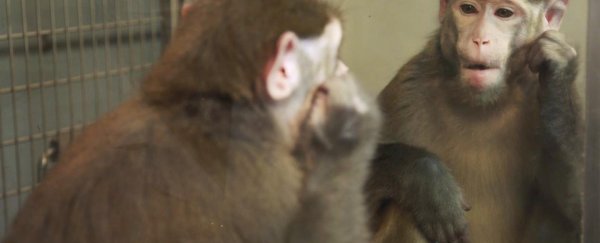From the age of two, humans are able to look in a mirror and realise that it's their own face staring back at them. Other animals such as great apes and dolphins can do the same. But rhesus monkeys have never been able to work it out.
But now new research has shown that this doesn't mean they can't be taught. A team of scientists from the Chinese Academy of Sciences has managed to teach rhesus monkeys to recognise their own reflection in a mirror.
And once they figured it out, they quickly used the mirrors to check out their butts.
The research will help shed light on the neural basis of self awareness in both humans and animals, and also hints at future treatment opportunities for disease such as autism and Alzheimer's.
"Our findings suggest that the monkey brain has the basic 'hardware' [for mirror self-recognition], but they need appropriate training to acquire the 'software' to achieve self-recognition," said Neng Gong, who led the research, in a press release.
Earlier research showed that, although rhesus monkeys can use mirrors to observe other objects, they showed no signs of recognising themselves. This is assessed across scientific research with something called the standard mark test. As Carl Engelking explains in his blog for Discover magazine:
"Basically, researchers put a coloured, odourless marking on the face of an animal or shine a laser pointer at a particular place on their body. If, while looking in the mirror, the animal touches its own face or rubs at the mark, they pass the test."
No matter what researchers tried, they couldn't get the monkeys to do this.
But in the new study, the team took a new approach, and trained seven rhesus monkeys by sitting them in front of a mirror and shining a mildly irritating laser on their faces. When they touched the point on their face, they'd give them a treat. After they'd learned to do that, they repeated the process using non-irritating lasers and, eventually, an odourless red dye.
After two to five weeks of the training, the monkeys were put back in their home cages, which were decked out with full-length mirrors. The researchers then shined the laser pointer at different parts of the monkeys' bodies, and, seeing this in the mirror, the monkeys started picking at and touching the spot. Untrained monkeys didn't even acknowledge the dot when they saw it in the mirror.
To make sure the monkeys weren't just touching the laser point in the hopes of getting a reward, the researchers tested them by pointing the laser at an untrained monkey in their cage. Rather than touching their own face, they touched the mark on their friend's body.
The monkeys even touched their own faces (and then smelled their finger to find out what it was) when a virtual spot was put on a computerised mirror reflection of them.
It was proof that they'd passed the standard mark test. And once they'd figured out they were looking at themselves, they quickly used the mirrors to inspect other body parts that they can't normally see, such as their genitals, without being prompted. It's comforting to know that vanity isn't an exclusively human trait.
The research, which has been published in the journal Current Biology, provides some fascinating insight into how our brains regulate self awareness. It could also have some practical applications when it comes to brain disorders that stop humans from being able to recognise themselves in a mirror, such as schizophrenia, Alzheimer's disease and autism.
"Although the impairment of self-recognition in patients implies the existence of cognitive/neurological deficits in self-processing brain mechanisms, our finding raised the possibility that such deficits might be remedied via training," the authors write in the paper.
We can only imagine that the next step is investing in a selfie stick for them.
Sources: Discover, EurekAlert
